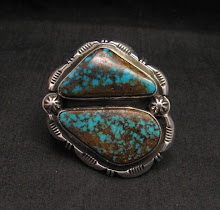 |
| Kirk Smith's Old Pawn Style Silver Jewelry |
Kirk Smith was one of the best Navajo silversmiths in recent times. His work was always top quality and he used only the best stones and materials. Kirk Smith was killed by a drunk driver in an unfortunate tragedy on September 17, 2012. He was only 55 years old and in his prime, both as a jeweler and as an individual. He will be deeply missed by family, friends and Native American Indian jewelry collectors and traders everywhere.
youngster in the 1960's at his grandfather's workshop. He made jewelry off and on until 1980, when
he returned to silversmithing full time, working with and learning from well-known artist and brother-in-law Harry Morgan. Kirk became an acclaimed artist is his own right by consistently creating investment quality old pawn style jewelry. With heavy silver, detailed craftsmanship and beautiful stones, Smith's pieces won many awards through the years. Although he changed his style over the years, Kirk remained true to the traditional heavy silver work of the Navajo. At the time of his death, Kirk had surpassed his one-time mentor, the late Harry Morgan, becoming one of the best practitioner of classic revivalist Navajo design.

Kirk always tried giving back to his people. He taught silversmithing to several other well known silvermsiths, including some of the Martinez family, Fred Brown, Dean Brown and Anthony Skeet. He also was one to help many Navajo different families whenever he could.
We are fortunate to have obtained a large selection of Kirk's bracelets, rings, earrings and pendants shortly after his death. Kirk Smith's work is considered collector and investment quality. With the recent price increases in both turquoise and sterling silver in the last few years, Kirk's beautiful pieces are an excellent investment not only in terms of their high quality turquoise and precious metal but because of the acclaimed artist who created them.
Check out our selection of Kirk Smith jewelry on our website and Ebay below.










